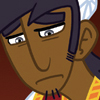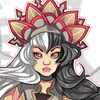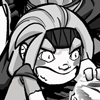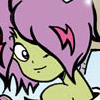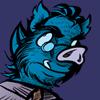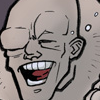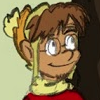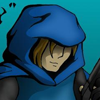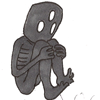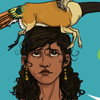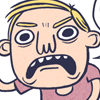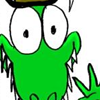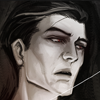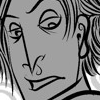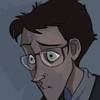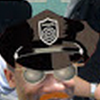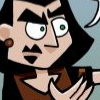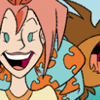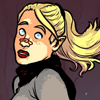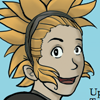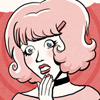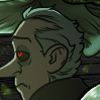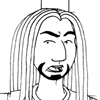Monthly Archives: September 2016
The generational divide that shouldn’t exist
Sarah’s Scribbles is speedy fantastic strip about young adulthood. It’s kind of the modern version of Cathy, and I mean that in a good way. As in, this is a strip that compares Jackson Pollock paintings to having a period. Oh, Sarah… will you ever win?
Then I ran into this strip:

So, as a Generation X type person, this got me thinking. Not negatively of Sarah Andersen, mind you: I do believe her feelings on this are genuine like the rest of her comic strips.
Consider this, though: you could easily have made this strip 20 years ago. The guy with the face could’ve been “Baby Boomers,” and he could have been saying, “Typical lazy Gen-X’er!” It actually shocked me more that the Gen-X guy is perceived as a super-successful dude. Seriously… I thought everyone saw us as slackers.
I mean, that’s how Generation X got its name, right? I know, the “X” made it look cooler than it really is, like we all have mutant powers or something. The “X” stood for a lack of identity. That it was a generation of lazy bums who had no idea what to do with their lives. Growing up, we were inundated by editorial cartoons and media telling everyone that we were the “lost” generation.
Maybe our choice of music wasn’t helping. “Did you hear that song they’re listening to? It says, ‘I’m a loser, baby, so why don’t you kill me’! There’s no way they’re going to amount to anything.”
(Incidentally, one of my most vivid memories of my dad? Him plopping down a magazine article in front of me that was titled: “The ballad of the lazy teenager.”)
For the most part we all still feel that sense of inadequacy. Here’s a fairly recent strip by fellow Gen X’er Ted Rall:
Curiously, you get the view from the other side… you know, the guy with the GEN X face in the first strip… and it’s almost the exact same story.
So here’s what I think is happening:
- Every generation feels inadequate. Millennials feel inferior to the Gen-X’ers, Gen-X’ers feel inferior to the Baby Boomers, the Boomers feel inferior to their WWII-vet parents, etc. The natural outgrowth of parenting means that mom and dad are usually held to an unrealistic high standard, meaning that no matter what you do you will always feel second place. You rationalize hard why you feel that way. For Sarah Andersen it’s crippling debt. For Ted Rall it’s the lack of any respect.
- Every generation has its successes. Not everyone is a Bill Gates or a Mark Zuckerberg. But if the successful people crow, it’s because it’s a sense of relief that the destiny threatened by their elders — that of utmost failure — did not come true.
So why do we even have this generational divide? We’re all i the same boat, feeling like everyone is literally against us.
Then again, maybe it’s good to be antagonistic Otherwise you get self-congratulatory garbage like this:
… which can screw right the hell off.
Know Thy History: Garfield
 Garfield may literally be the only character that doesn’t need a Know Thy History, because the guy never went away. Who doesn’t know all the comics’ beats? He hates Mondays and he loves lasagna. When I when to Abu Dhabi some time ago, I was a little disappointed Nermal wasn’t there. There’s plushies stuck on car windows. Roger Ebert once pretended he was him. And one webcomic speculated a world without him… a scenario that is fantastical for Garfield is always with us. He will never forsake us.
Garfield may literally be the only character that doesn’t need a Know Thy History, because the guy never went away. Who doesn’t know all the comics’ beats? He hates Mondays and he loves lasagna. When I when to Abu Dhabi some time ago, I was a little disappointed Nermal wasn’t there. There’s plushies stuck on car windows. Roger Ebert once pretended he was him. And one webcomic speculated a world without him… a scenario that is fantastical for Garfield is always with us. He will never forsake us.
And, perhaps unfairly, Garfield gets tagged with being ultimately lazy. (I mean, the strip. There’s no doubt the cat is lazy.). It is, after all, a strip that seems to be recycling the same gags ad infinitum. The Lasagna Cat video series reenacted Garfield strips, pointing out how utterly square the comic is by pairing the accurate delivery with a bonkers music video. Slate posted the following answer to “Is Garfield supposed to be funny?”:
Garfield was never intended to be humorous. The joke’s always the same because it follows a bland humor formula well-known to anyone in advertising: enough to put a smile on someone’s face, but take care never to offend. And if the humor has to suffer for it, fine.
Ouch.
Wither Cyanide & Happiness?
The precipitous drop of Cyanide & Happiness readership seems at first to be alarming. Its contemporaries have managed to hold on to its readership over the years. Cyanide & Happiness seems to be shedding them. Why? Is it because the webcomic, at its core, is really juvenile, and as readers grow up they stop reading stuff where the punchline is generally someone exposing their buttocks? It’s like Jim Henson’s rule that a Muppet Show segment must end one of two ways, only it’s butts.
I think that my theory may still be sound, since Cyanide & Happiness did the smart thing and followed their audience. In other words, they went to YouTube. As Dave McElfatrick mentioned in The Observer: “Right now, our comics are no longer our primary income stream. They used to be for many years, but since then our business has had to change and adapt to the shifting tides of the Internet—it’s been a difficult transition at times, but we’re still able to do what we love doing, which is the ultimate blessing, really.”
The strategy seems to be paying off. Their channel is approaching 7 million subscribers, and the cartoons are of generally high quality. This isn’t Blind Ferret’s CAD toons… or even (sigh) Blind Ferret’s Tiny Dick Briefs. It’s got good voice acting and decent animation.
Check out this Bear Grylls parody, which as of this writing has 11 million views.
Yeah, it basically boils down to some guy exposing his naked buttocks. But, God help me, I laughed.
WCO.240: The GaMERCaT

Once upon a time, two guys write a webcomic about video games. This got everyone’s attention because no one had ever done it before. The comic seemed to say, “Hey guys, we have a hobby that no one has ever made jokes about really. Come here and enjoy our gamer jokes and our references that people in the mainstream won’t make because they think it’s too obscure.”
There guys got successful, and people paid attention. Many readers loved video games too and also loved to draw. Suddenly, new comics seemed to pop up all the time with jokes about video games. People kept reading them and buying T-shirts depicting licensed products like the kind you’d find tightly sandwiched between other shirts on a table at the neighborhood flea market.
But as video games became more mainstream, a lot of the humor seemed tired and repetitive. There are only so many times you can mock politicians who are critical of video game violence, after all. Especially when that fount of rage ceases to become a pressing issue anymore. After almost 20 years, there had to be some way to keep the humor fresh in a world where The Big Bang Theory is the highest rated show on television.
What about a website that combines the internet’s biggest obsession in the aughts: video game webcomics … and cats?
No, not that one. A different one. I’m talking about The GaMERCaT, Samantha Whitten’s far more recent webcomic with a feline twist.
What your Twitter icon says about you

Social media is perhaps the most effective way currently to get other people to know about webcomics. Sharing, linking, and posting panels are a great way for a webcomic to build an audience. But how do you sort through the clutter? According to Digital Information World, about 71% of tweets are ignored. Meanwhile, as The Observer noted, the Internet has moved to a point where fewer and fewer people move out of Twitter, Facebook, and Tumblr. How do you even get someone to give a webcomic a first look on interfaces that are meant to reward only those with short attention spans?
One way is to have a catchy logo. Logos help to separate the clutter that builds up on the left side of the Twitter app. Great ones communicate many ideas in just one single and simple image. This only gains more power through repetition, something that Twitter, especially, is built for. Here are a few Twitter icons from popular webcomic-related sites.
Penny Arcade: The uber-simplistic Twitter icon very much says, “We are serious and corporate.” This is the sort of icon you aren’t ashamed bring to your board room meetings with the investors. I do like how Penny Arcade also tries to own the color orange, though it does clash with some fundamentals here. For a company based in the Pacific Northwest and is associated with technology and video games, they picked a color best associated with the Denver Broncos and storage rental facilities.
Rating: 3/5
The Oatmeal: Matt Inman recently has been on a crusade to disabuse people about their guilt over loving sweets. So it’s kinda appropriate that his twitter handle is some guy who is overjoyed beyond all human measure standing in front of what looks like a giant lollipop.
Rating: 4/5
Ctrl+Alt+Del: This is basically just a screenshot of the site’s header. Which is not WRONG, per se… but given Twitter’s tiny amount of real estate it make so much more sense to make that green logo front and center. Weirdly, this is the second video game webcomic on here, and neither actually screams video games at first glance. I guess everyone’s too good for pixel art these days?
Rating: 3/5
Dinosaur Comics: Hey, it’s the dinosaur from Dinosaur Comics? What did you expect? It’s a comic that recycles the exact same panels from strip to the next. Did you expect Ryan North to go nuts here? Look, it’s not like it’s exactly surprising that this is what the Twitter icon would look like. It’s just sort of the Twitter icon version of the Toyota Corolla. Works well, but, you know, not that exciting.
Rating: 3/5
Topatoco: Webcomic-related online retailer Topatoco typically has a more streamlined-looking mascot. However, their twitter handle scuffs up that perfect skin with a series of unsightly lesions to the point that he looks more like a flying potato. I’m going to guess this was drawn by webcomic artist, KC Green, so I’m inclined to give it a pass, but to me it looks like the little guy needs to go to the doctor to have that rash checked out.
Rating: 2/5
Questionable Content: It’s a farting anime girl.
…
Sold!
Rating: 5/5
Wait what the heck is this garbage? This is clearly something made from one of those cheap icon-creating apps. Rating: 0/5
Feedback Overlook: Thanks for the welcomes

I just want to say thanks for all the kind “welcome back”s from all the folks who, for some reason, are still following this site despite it going on hiatus for two years. I mentioned it on the comments section of another site, but it’s a really great feeling to have so many folks genuinely happy that I brought The Webcomic Overlook back online. It’s heartening… and a little daunting. I’ve got big anime sweat beads on my head. Fortunately, I have a few billion ideas burning in my brain to keep me occupied in the coming months.
Webtoons! Worth it?
Homestuck! Did it stuck its landing?
The webcomic influences on Undertale, one of the most critically acclaimed video games of recent times!
Where should webcomics go in the ever changing online world?
And Garfield. (Seriously. Scott Kurtz’s recent arc on PvP got me thinking Garfield.)
Before I go on, I’d be not doing my job if I didn’t post a wonderful “welcome back” from Gary Tyrell of FLEEN (the “Elcoertnic Swiss Army Knife”, according to its tagline). Gary’s been blogging about webcomics far longer than I have, and probably didn’t take any breaks. Anyway, he had some comments on my piece, “The State of the State of Webcomics“:
- Elsewhere on the web, Larry El Santo Cruz has been absent from Webcomics Overlook for about forever, but he’s back! An account of the Blerch Run in Seattle on Sunday, an analysis of Webcomics: Still A Thing? yesterday, and a piece on webcomics, webtoons, and phones today. It’s the middle one I want to talk about.El Santo’s a smart guy, and if he’s musing on if webcomics is still a meaningful term, I’m all ears. I got pulled up short, though, when he concluded his comparison of webcomics against its nearest competitors (newspaper strips once, memes now) with this description:Webcomics exist in that nebulous undefined region between passing fad and real art, with aspiring artists edging toward the latter. But… due to the market reality, most webcomics are not the best in either field. Too good to be a meme, not got enough to be art.I get what he’s trying to say, but to say that webcomics are not got [sic] enough to be art is, at best, short-sighted. To pull up merely the most recent examples of webcomics embodying art — and here, I’m defining that as the ability to convey point of view and emotion, not merely the visual component — consider two Achewoods and one Schlock Mercenary of current vintage.
Everything you need to know about Ray, Cornelius, and Téodor is encapsulated in that wordplay; the depth of character is staggering, whether you’ve ever visited Achewood before or not. And I’d challenge you to find a bit of dialogue that expresses the costs of soldiering — a topic that is overlooked far too easily while we engage in prominent displays of support for the troops — more succinctly or with deeper understanding than that discussion between an uplifted polar bear, a four-armed alien, and a sociopathic amorphous blob with a sudden attack of conscience. To paraphrase the immortal Ike Willis, I got yo art hangin’, boy².
Which is me being overly wordy in saying: we settled this a long time ago. Webcomics are comics. Comics are art. The transitive closure is left as an exercise for the reader, as is my instruction that you all bookmark The Webcomics Overlook and pay attention to El Santo.
Thanks, Gary! And while I generally agree, I do hope to debate this topic again with you in the future! Like some weird webcomic version of Demosthenes and Locke.
Anyway, that’s all for now. I got a couple of webcomics I’d like to review, so you can expect seeing some new content here at the Webcomic Overlook soon.
Webcomics vs. webtoons: the smartphone challenge
Korea has made some impressive inroads with their version of webcomics. Known as webtoons or manhwa, these comics have been accessed by 13 million users (versus an estimated 100,000 webcomic readers in the US). Most are free. Quite a few have been adapted to film and TV.
And they’re making inroads in the US.
Here’s a demonstration where webtoons have an advantage over Western-style webcomics.




















